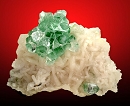
|
| Apophyllite |
Chemical
Formula |
(K,Na)Ca4Si8O20(F,OH) ? 8H2O |
Species |
Silicates |
Mohs
Scale |
4-5 |
Specific
Gravity |
2.3-2.4 |
Color |
Usually white, colorless; also blue, green, brown, yellow, pink, Purple |
Streak |
White |
Luster |
Vitreous, Pearly |
Refractive
Index |
n = 1.535 n = 1.537 |
Diaphaneity |
Transparent to translucent |
Cleavage |
Perfect |
Fracture |
Uneven |
| Crystal Habit:prismatic, tabular, massive |
The name
apophyllite refers to a specific group of phyllosilicates, a class of minerals that also includes the micas. Originally, the group name referred to a specific mineral, but was redefined in 1978 to stand for a class of minerals of similar chemical makeup that comprise a solid solution series, and includes the members apophyllite-(KF), apophyllite-(KOH), and apophyllite-(NaF). The name apophyllite is derived from the Greek ?π?Φυλλ??ο
apophylliso, meaning "it flakes off", a reference to this class's tendency to flake apart when heated, due to water loss. These minerals are typically found as secondary minerals in holes in basalt or other igneous rocks. They can also be called "fisheye stone". A recent change in the nomenclature system used for this group was approved by the International Mineralogical Association, removing the prefixes from the species names and using suffixes to designate the species.
Though relatively unfamiliar to the general public, apophyllites are fairly prevalent around the world, with specimens coming from some of the world's most well-known mineral localities. These localities include: Poona, India; the Harz Mountains of Germany, Mont Saint-Hilaire in Canada, and Kongsberg, Norway, with other locations in Scotland, Ireland, Brazil, Japan, and throughout the United States.
Uses
Apophyllites are popular as collector's minerals. This popularity is due to a combination of factors, including their abundance, color variety, and well-defined crystals. Naturally forming pyramidal structures, they refract light in obvious rainbows, and can form "natural pyramids" when subjected to rock tumbling.
Species of Apophyllite
- Apophyllite-(KF) (formerly fluorapophyllite), (K, Na)Ca4Si8O20(F, OH) · 8H2O - white, colorless, yellow, green, violet
- Apophyllite-(KOH) (formerly hydroxyapophyllite), KCa4Si8O20(OH, F) · 8H2O - white, colorless
- Apophyllite-(NaF) (formerly natroapophyllite), (K, Na)Ca4Si8O20F · 8H2O - brown, yellow, colorless


 YueGongAnBei 44051102000467
YueGongAnBei 44051102000467


 |
|